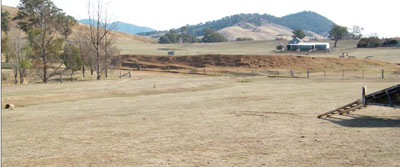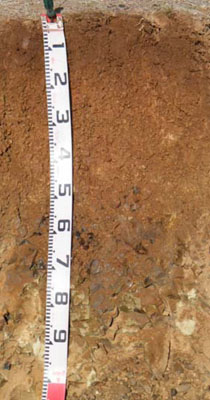EGC200
Location: Bindi
Australian Soil Classification: Haplic, Lithocalcic, Red DERMOSOL
Map Unit: Bindi (Component 1)
Previous Site Name: EG200
General Landscape Description: Undulating low hills
Site description: Upper north facing slope
Land Use: Grazing on annual pasture
Native Vegetation: Grassy woodland
Geology: Devonian limestone

Soil Profile Morphology:
| Surface soil |  | ||
| A1 | 0 – 17 cm | Dark brown (7.5YR3/2); clay loam; moderate fine (2 – 5 mm) granular structure; firm consistence dry; clear change to: | |
| Subsoil | |||
| B21 | 17 – 30 cm | Reddish brown (2.5YR4/4); medium clay; strong medium (10 – 20 mm) polyhedral structure; very firm consistence dry; few (2 – 10 %) angular limestone pebbles (up to 10 mm in size); gradual change to: | |
| B22 | 30 – 40 cm | Red (2.5YR4/6); medium clay; strong medium (10 – 20 mm) angular blocky structure; very firm consistence dry; many (20 – 50%) angular tabular limestone pebbles (up to 20 mm in size); gradual change to: | |
| B23 | 40 – 55 cm | Red (2.5YR4/6); medium clay; very firm consistence dry; abundant (50 – 90 %) angular tabular limestone pebbles (up to 60 mm in size); clear change to: | |
| R | 55 – 110+ cm | Fractured limestone becoming impenetrable with depth. |
Key profile features
- Lack of texture contrast between the surface (A) horizon and the subsoil (B) horizon.
- The shallow occurrence of limestone rock.
Soil Profile Characteristics:
- | pH | Salinity | ||
Surface soil (A1 horizon) | Strongly Acid | Very Low | Non-sodic | None |
Subsoil (B21 horizon) | Moderately Acid | Very Low | Non-sodic | None |
Deeper subsoil | Slightly Acid | Very Low | Non-sodic | None |
Chemical and Physical Analysis:
Horizon | Horizon Depth (cm) | pH (water) | pH (CaCl2) | EC dS/m | Organic Carbon % | Total Nitrogen % | Exchangeable Aluminium ppm | Exchangeable Acididty meq/100g | Exchangeable Cations | Coarse Sand (0.2-2.0 mm) % | Fine Sand (0.02-0.2 mm) % | Silt (0.002-0.02 mm) % | Clay (<0.002 mm) % | Field Capacity % w/w | Wilting Point % w/w | |||
Ca | Mg | K | Na | |||||||||||||||
meq/100g | ||||||||||||||||||
A1 | 0-17 | 5.3 | 4.6 | 0.11 | 4.3 | 0.38 | <10 | 9.5 | 7.3 | 1.5 | 0.74 | 0.085 | 8 | 18 | 23 | 41 | 34.5 | 15.5 |
B21 | 17-30 | 5.9 | 4.7 | 0.06 | 1.5 | 0.14 | <10 | 6.8 | 8 | 2.9 | 0.5 | 0.11 | 6 | 10 | 11 | 66 | 30.6 | 17.0 |
B22 | 30-40 | 6.2 | 5.7 | <0.05 | 1.3 | 12 | 7.5 | 8.7 | 4 | 0.33 | 0.15 | 2 | 7 | 16 | 70 | 31.8 | 19.7 | |
B3 | 40-55 | 6.2 | 6.6 | <0.05 | 0.61 | 14 | 5.8 | 8.3 | 3.9 | 0.29 | 0.14 | 13 | 7 | 27 | 50 | 24.4 | 13.9 | |
Management Considerations
Whole profile
- Plant available water here is considered to be moderate. Because of the variability in the depth of soil cover within this mapping unit, many soils will have low to very low water-holding capacity. Effective rooting depth is limited to the depth to rock.
- The surface soil here is strongly acid. This is inconsistent given the presence of lime in the subsoil. Lime is added to acid soils is to increase the availability of phosphorus and molybdenum so if soil tests taken across the paddock show the soils are deficient, superphosphate should be applied. If no response is observed, lime may used to alleviate the problem.
- The soils are low in soluble salts.
- Potassium levels are moderate and plant responses to potassium fertiliser are unlikely given the present grazing management practices.
- The nutrient holding capacities of the surface (A1 and B21) horizons are moderate (based on the sum of the exchangeable calcium, magnesium, potassium and sodium cations).
- The subsoil would be relatively well drained as there is no sharp increase in clay content at the A/B boundary. The subsoil horizons are non-sodic and not coarsely structured, which will enable plant roots to penetrate easily until they reach rock.
Profile Described By: Heather Adams, Julieanne Sargant and Ian Sargeant, June 2009.


